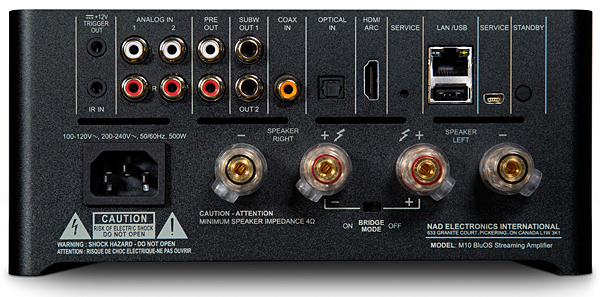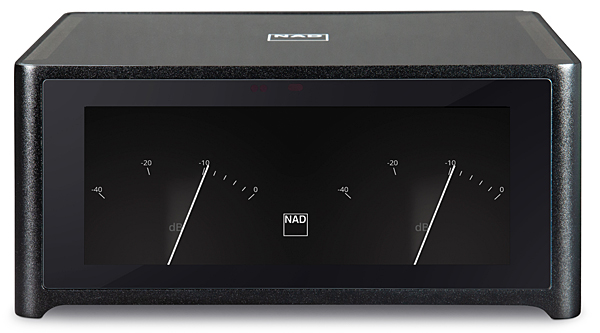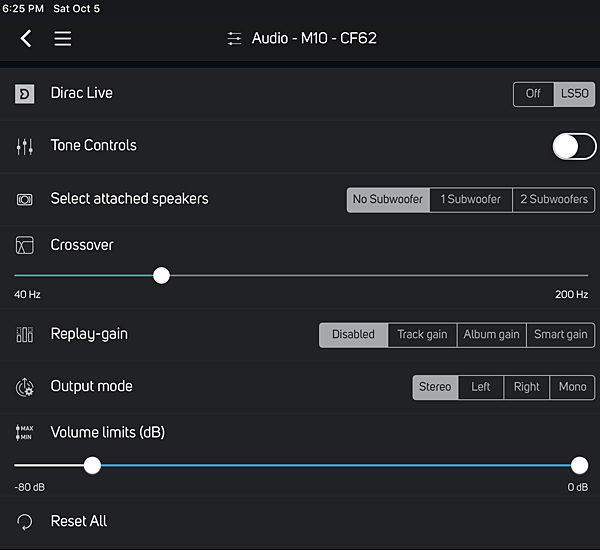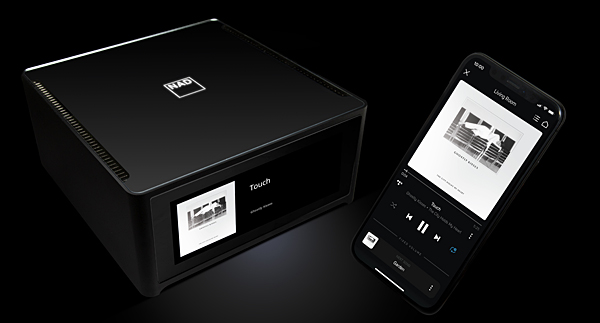| Columns Retired Columns & Blogs |
Another nominee for Stereophile 2020 product of the year award, NAD M10 :-) ........

In the spring of 2019, NAD introduced the Masters Series M10 ($2749). At first I assumed that the M10 was a stripped-down, less-powerful version of the M32, but the new amplifier offers a unique set of features.
Like the M32, the M10 offers analog and digital inputs, but here the BluOS functionality, with its network, Wi-Fi, and Bluetooth connectivity, is included rather than optional. Yes, both amplifiers use a digital output stage, but while the M32 uses a "DirectDigital" amplifier that takes a digital signal as its input, the M10's "Hybrid Digital" amplifier takes in an analog signal. The M10 also offers 50W less power than the >150W claimed for the M32. But NAD specifies that the M10 will offer "Dynamic Power"—ie, when the power demand is short-lived, as it would be with musical transients—of 160W into 8 ohms and 300W into 4 ohms.

The M10 includes multiroom capability and is compatible with home control systems from Crestron, Control4, and Lutron. But more significantly for Stereophile readers, purchasers of the M10 receive a free license to use Dirac Live Room Correction with their new amp. (This can be upgraded to a paid Dirac Live Full Frequency version.) The M10 is supplied with a USB microphone that can be used to measure the responses of the owner's loudspeakers at the listening position; the Dirac app then creates a digital filter to optimize the sound, after which the amplifier's digital signal processing corrects the signal on the fly.

Design
The M10 is a small, elegant-looking amplifier—it is just 8.5" wide—finished in black with the front and top panels formed from "Gorilla Glass." The top panel has an illuminated NAD logo, with a color that indicates various things that are happening inside. (In operation it shines a chaste white.) The front panel comprises a full-width, color TFT touchscreen with a proximity sensor—it senses when your finger is close and offers you items to choose from the menu. The menu itself is too complicated to describe here; suffice it to say that it allows a wide range of functions, including tone controls and crossover frequency for one or two subwoofers (see the screenshot). When the M10 receives streamed audio, the display shows the album cover art, artist, album, composer, and track name. When the M10 receives S/PDIF digital audio and analog signals, the display shows a large pair of white-on-black VU meters.

As well as two pairs of terminals for loudspeakers and the usual 15A IEC power jack, the crowded back panel has two pairs of RCA jacks for analog input signals; a pair of preamplifier output RCA jacks; a pair of subwoofer output RCA jacks; coaxial and optical S/PDIF input ports; an HDMI port for connecting any TV that supports HDMI Control (CEC) and Audio Return Channel (ARC) functions; a combined Ethernet port and Type A USB port; a standby button; a switch for turning the M10 into a bridged-mono amplifier; and various service and trigger jacks. The M10 has Wi-Fi and Bluetooth connectivity; its USB port can accept thumb drives containing music files; and it can access music files stored on a network-attached drive using the BluOS Controller app or Roon. The M10 supports all the common file formats, including MP3, AAC, WMA, OGG, WMA-L, ALAC, OPUS, DSD, FLAC, WAV, and AIFF, with sample rates up to 192kHz and 16–32 bit depths. It can unfold MQA-encoded data and also supports Spotify, Amazon Music, Tidal, Deezer, Qobuz, HDTracks, HighResAudio, and many more streaming services, as well as internet radio.
Inside the box, the M10's brain is an ARM Cortex-A9 processor running at 1GHz. Analog signals are digitized and all the audio data are converted to analog with a 32-bit ESS Sabre DAC chip. While this can decode data sampled up to 384kHz, the maximum rate the M10 can handle is 192kHz. As mentioned above, the M10's output stage is based on the well-regarded Hypex nCore modules, which take negative feedback from after the class-D stage rather than before, to better control the loudspeakers.
Setup
Though I didn't try doing so, the M10 can be voice-controlled by Amazon's Alexa and Apple's Siri. As the M10 doesn't have a conventional remote control, it needs to be connected to a network, either Wi-Fi or Ethernet, for full functionality. Following the excellent instructions in the manual—supplied on a USB thumb drive—I connected the M10 to my network with Wi-Fi using the BluOS Controller app running on an iPad mini. As appears to be the norm these days, the amplifier contacted homebase to see if its firmware needed to be updated. It did, so I waited while the update was downloaded and installed—the NAD logo on the top panel flashes red during this process—after which the M10 rebooted itself and was ready to play music. I later used a wired network connection but didn't hear any difference between the two modes (footnote 1).

play CDs, as I didn't have a long-enough coaxial cable I connected the AES/EBU output of my Ayre disc player to a VSP digital format converter so I could send the data to the M10 via a 15' Toslink optical connection. While the BluOS app can be used to access a music library, I mostly used the Roon app—Roon recognizes the M10 as a Roon Ready zone—to send music data to the M10 via the network. Roon also recognized the NAD as an Airplay device, which I used to listen to internet radio from my Mac mini. I used four pairs of loudspeakers during my auditioning: the inexpensive PSB Alpha P5s that I reviewed in the October 2019 issue and that were my personal 2019 Product of the Year; my long-term reference KEF LS50s; my vintage Rogers LS3/5a's; and the Q Acoustics Concept 300s, which I review elsewhere in this issue.
Listening
Before installing the M10 in my system, I had been listening to my resident pair of KEF LS50s driven first by a pair of Lamm M1.2 Reference monoblocks, then by the Vandersteen M5-HPA monoblocks I had used with the Vandersteen Quatro Wood CT loudspeakers that I reviewed in the November 2019 issue. The latter had their high-pass frequency set to 20Hz so they would, in effect, be driving the KEFs virtually full-range. As you might expect, these very much more expensive amplifiers—the Lamms cost $32,490/pair, the Vandersteens $15,800/pair—set a high bar for the M10. Both made the KEFs sound considerably larger, more authoritative than you might expect from what are relatively small speakers. In particular, the Vandersteen M5-HPAs proved a particularly synergistic if unlikely match. I further explore the performance of this amplifier in my review of the Q Acoustics Concept 300 elsewhere in this issue.

Another nominee for Stereophile 2020 product of the year award, NAD M10 :-) ........

'Thin Red Line' and 'Bold Red Line' :-) .........

The Transistor was the most important invention of our last Century, wasn't it?
This high-achieving little box seems like a dam nice 1980 Era Hifi extrapolated out into our new 21st Century needs. ( I haven't yet had the chance to ask my Michigan NAD Critic if this box is serviceable or if it's another unserviceable throwaway, as so many electronics from Asia seem to be nowadays ).
As I started reading this review I'd thought that the device was the size of a BIG Mono Amplifier. Of course, it isn't at all "Large" unless it's compared to an iPhone or a Dragonfly .
Its amazing that a little device like this could be sooooooo dam powerful. Phew, seems like a parade motorscooter the Shriners ride but with 3,000 horsepowers.
Yet as powerfully potent as this NAD is, only a few pages away is a descriptive comparison of two low power amps serenading our HR into blissful oblivion.
Ultra high performing 21st Century Transistors vs. low power Valves ? Can I have both?, pleeeeeezzzzeeee
Tony in Venice ( all over Primary country & Counties )
ps. as much as I've abandoned ( and discourage ) vinyl hoarding, Mr. Dudley's writings are delightful ( especially the Naim Quad descriptions )
ps. thank you for the delightful read whilst out on the lonely trail.

... eat it too? Absolutely.
Just connect the pre-amp outputs of the NAD M10 to the inputs of a Luxman MQ-300 8W triode tube power amp.
http://www.luxman.com/product/detail.php?id=17

Are you spending any time in 'wine caves' and drinking from '$900 a bottle wines', Mr.Tony? :-) ........

I'm in plenty of Plane Hangers, all without booze.
I don't see the money collecting, ever.
I'm involved with the nuts & bolts of keeping the Big Show on the Road, in the Air and not missing dates or scheduling.
This is an unsettling lifestyle that some people thrive in, I'm not one of em. It's a Carnival like Ringling Brothers, we are anticipating a three fold increase in busyness & activity. Bernie's nomination will make everything we know seem tame. ( we're told )
I might be too old to keep up.
Fingers Crossed
Tony in Venice ( for a breather )

... running to catch a train, as does the 70-year-old Sen. Warren.
https://www.youtube.com/watch?v=FKHbJEAs2D4

Thanks for the advice.
I've just ordered a used "Royal Canadian Air Force Exercise Manual" from eBay and promise to begin my Training Program as 2020 rolls out. Exercises include Running which will probably be the hardest part of the 5BX group considering that I'm too outa shape to be exercising.
Lovely News:
I've been on a Cancer Alert since early 2017 and just went Clear by my latest Radiologist Reporting from Nov. Phew !!!
I'm no longer living in fear.
I have no health issues: A miracle considering how I've smoked 15,000 packs of Cigs.( lifetime ) and guzzled 5,000 fifths of Hard. ( from 1985 to 2000 )
I'm feeling lucky
Tony in Venice
ps. I'm still on Oakwood Cemetery's rather long waiting list

Mr. TonyKaz: the best comment you have made in a long time. Don't pay too much attention to us doctors, just open your eyes (and your ears!) Daily and marvel at the magic that surrounds you. God bless you, Merry Christmas!

... just get a decent pair of shoes and go for a walk.
Three to four miles per day is a good target.
The 5BX plan is an excellent strategy, too.
https://csclub.uwaterloo.ca/~rfburger/5bx-plan.pdf

Are there any 70-year-olds here at Stereophile, who can run and catch trains? ....... I wonder? :-) .......

...run faster than a train. It wasn't speeding, it was in fact nearly stopped, but still, John was running at a good clip.
Happy Holidays to everyone. And glad to hear you're healthy as a horse, Tony.
Peace and love,
Rob S.

John Atkinson is actually Superman ....... You missed to see that cape? ....... Happy Holidays :-) .......

Thank you for writing, nice to hear from y'all.
We have a smallish group ( in Venice Fl. ) of Octogenarians running the Waterfront/Inter-coastal Trail, it's impressive seeing what Id've thought was impossible ( and is in the Frozen North ). I might be joining them. Flying back to Sarasota is like returning to Paradise, moving here is proving to be a dam good decision.
Hmm, JA on running in NY, I wonder.
JA on running Stereophile: retired JA seems to be doing ever more beautiful writing as are a number of regular contributors. These guys are raising their Game, that Naim/Quad story rivals the best writings. Editorial content is consistently deep, philosophies are revealed, wisdoms are being explained. 5,000 well thought-out word review/stories in abundance. Audiophile or not, Stereophile rivals any Mag. on the Stands for intelligence, it's one of the best kept secrets in Publications. ( the ones I travel with get worn out by multiple readers )
Now, I hope & wish that Tyll would return to Print from the High Planes of New Mexico. ( Bob Katz, too )
Tony in Venice

Run, run away fast.

I've used NAD products for about 20 years, starting with an 80-watt integrated, then moving up to their pre- and power amp combo and CD player, and finally to their wonderful M51 DAC. Unfortunately -- based on Mr. Atkinson's recommendations -- I also bought their M32 "direct digital" amplifier and their M50.2 server. My experience is that their older equipment not only sounds better, but is MORE DEPENDABLE than their new stuff.
After using it for a couple of months, with its hard drive only half full, my NAD M50.2 now simply refuses to rip any new CDs. After listening to the M32 for several months, I've now gone back to the M51 DAC and NAD power amp combination. The M32 had an irritating forwardness in the upper midrange that became unpleasant over time, whereas their earlier DAC and analog power amp sound much better.
Mr. Atkinson, how long did you actually live with these products? I frankly am having trouble trusting your reviews of them.

Mr. Atkinson, how long did you actually live with these products? I frankly am having trouble trusting your reviews of them.
I'm sorry to hear about the problems you had with the M50.2 and M32. Reviewers tend to live with a product for 4-6 weeks, so longer-term reliability is not something that can be examined in a review. In the case of the NAD M10, though I used it in my system for most of September and October before writing the review, I subsequently purchased the review sample. Putting my money where my mouth is, if you like. I will report if I have any issues.
John Atkinson
Technical Editor, Stereophile

Thank you for your reply. I was concerned not just with reliability but sound quality. Does the M10 sound better than the M32? I found the much cheaper combination of the M51 DAC and the old NAD C272 power amp to sound definitely better than the M32.

What loudspeakers are you using? ...... As you know loudspeakers make a big difference in sound quality :-) ........

Thanks for your sage advice. I've used several different speakers with the NAD M32 and the NAD M51-C272 combination. They include the Dynaudio Special 40 (nice, but an unpleasant upper midrange emphasis, at least in the nearfield where I listen). Aerial 5T (awful: upper bass bump, too little midbass, dry sound overall). Tekton Design Uruz (a pretty good low cost, essentially DIY design; excellent highs). And the Buchardt Audio S300 MkII: Better than the Dynaudio overall, with a more pleasing and relaxed balance and deeper bass. My current speaker for nearfield listening, which is almost always how I listen.
In my judgment the NAD M32 doesn't sound completely natural in the upper mids and highs, and easily becomes fatiguing and even irritating. I notice John Atkinson didn't "put his money where his mouth is" despite saying it was "highly recommended."

May be you could listen to/with KEF LS-50 and/or, may be Polk L-100 (which were favorably mentioned by RS in a recent dealer demo) ........ Both the KEF and Polk speakers are in the same price range :-) .......

The problem is not the speakers, despite your insistence. (I am curious about the new Polks though--the L200 more than the L100.) I'm actually quite happy with the NAD M51 / C272 / Buchardt Audio combination and plan to sell the M32 if I can. It just doesn't measure up--works OK for rock, pop, or electronic but not for classical. I'm especially pleased that the Buchardt's give me such a deep soundstage even though I listen in the nearfield and with the speakers close to the wall. And they are great all-rounders too. I hope Buchardt keeps developing new products.

May be you could try a tube integrated amp, like the Rogue Audio Cronus Magnum III, $2,995, for example :-) ......

... reading what I wrote.

HR liked the sound of Dynaudio Contour 20 with PrimaLuna tube amp, for example :-) ........

... near-field listening, have a listen to any of various models from Harbeth.

Glad you still have the NAD M10, with you JA1 .......... May be you could review the new Polk L-100 bookshelf/stand-mount speakers ($1,200/pair), which were favorably mentioned by RS in a recent dealer demo ....... L-100s are in the same price range as the KEF LS-50 :-) ........

If the NAD M32's "direct digital" system is so great, and you thought it was "highly recommended," then why did NAD go back to using the ESS Sabre/Hypex module approach here? Maybe direct digital doesn't sound so great after all?

JA1 could also review the new NAD M33, due for release in January 2020 ($4,999) ......... 200 WPC and has Purifi's 'Ultra-Quiet Amplification Technology' :-) .......

So, I've carefully followed NAD amp development.
I don't believe "hybrid" here refers to taking in both an analog and digital input. As far as I know, in the NAD product lineup the 3020D was among the earliest. As I recall, it is a hybrid because it runs a small, linear class A amp in between two Class D voltage rails. It's closer in topology to the Carver/Yamaha EEEngine type of designs. It may be designed with Hypex, but it is not a straight forward nCore either.
One of the dead giveaways is the idle power. It runs unusually hot for a pure class D.
Also, switching is not Class D, but if you are going to do A/D, then room correct, well, you wouldn't be wrong in calling it a digital amp anymore.
I comment on all of this because I am curious, not because I am sure, so if the good peeps at Stereophile can confirm or correct, that would be nice.
Best,
Erik

If you want to use a headphone amp connected to the pre out, what do you need to do to stop the speakers from getting amplification.

Anyone have any experiences upgrading the stock power cord? What about adding a power conditioner?